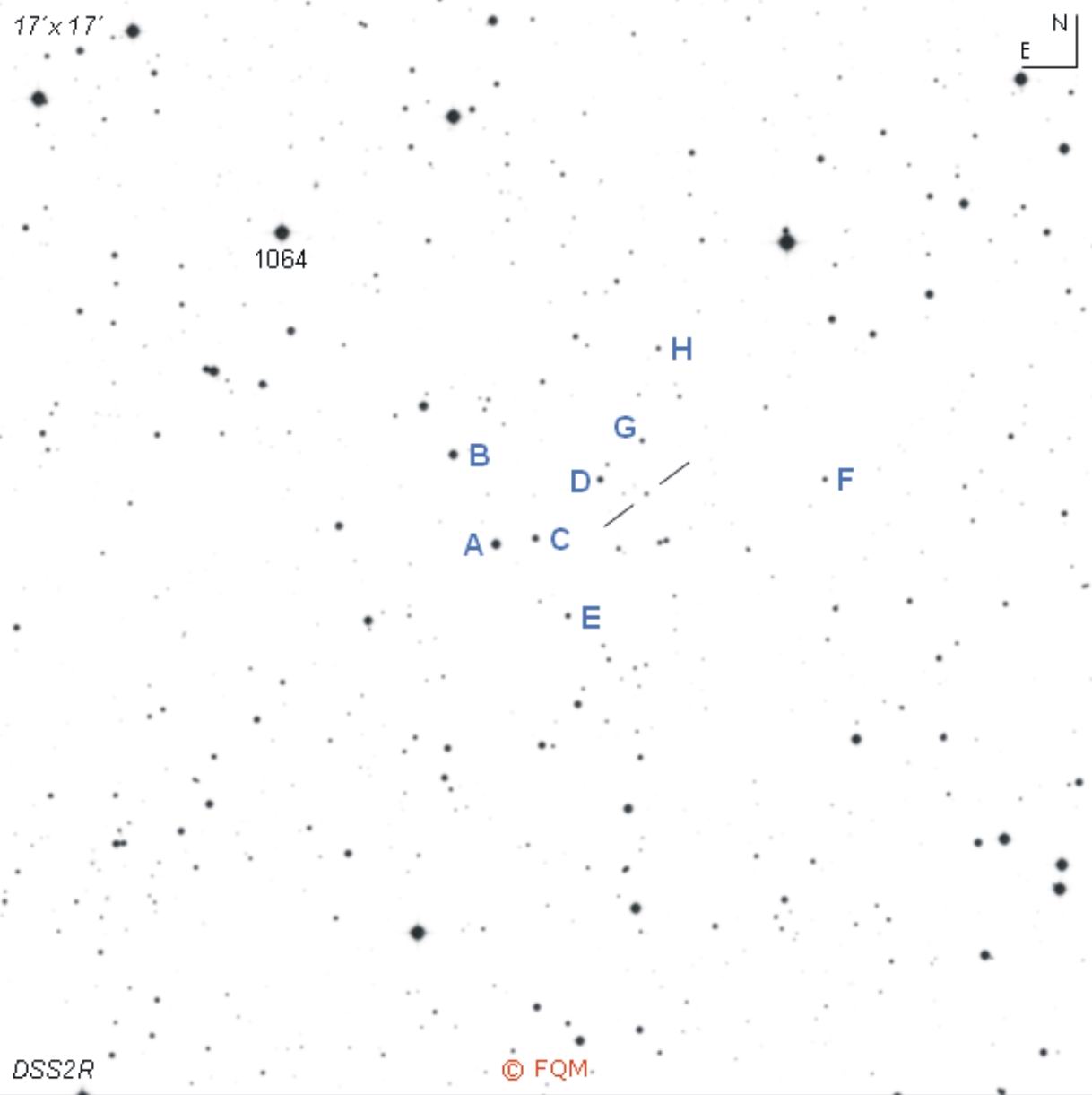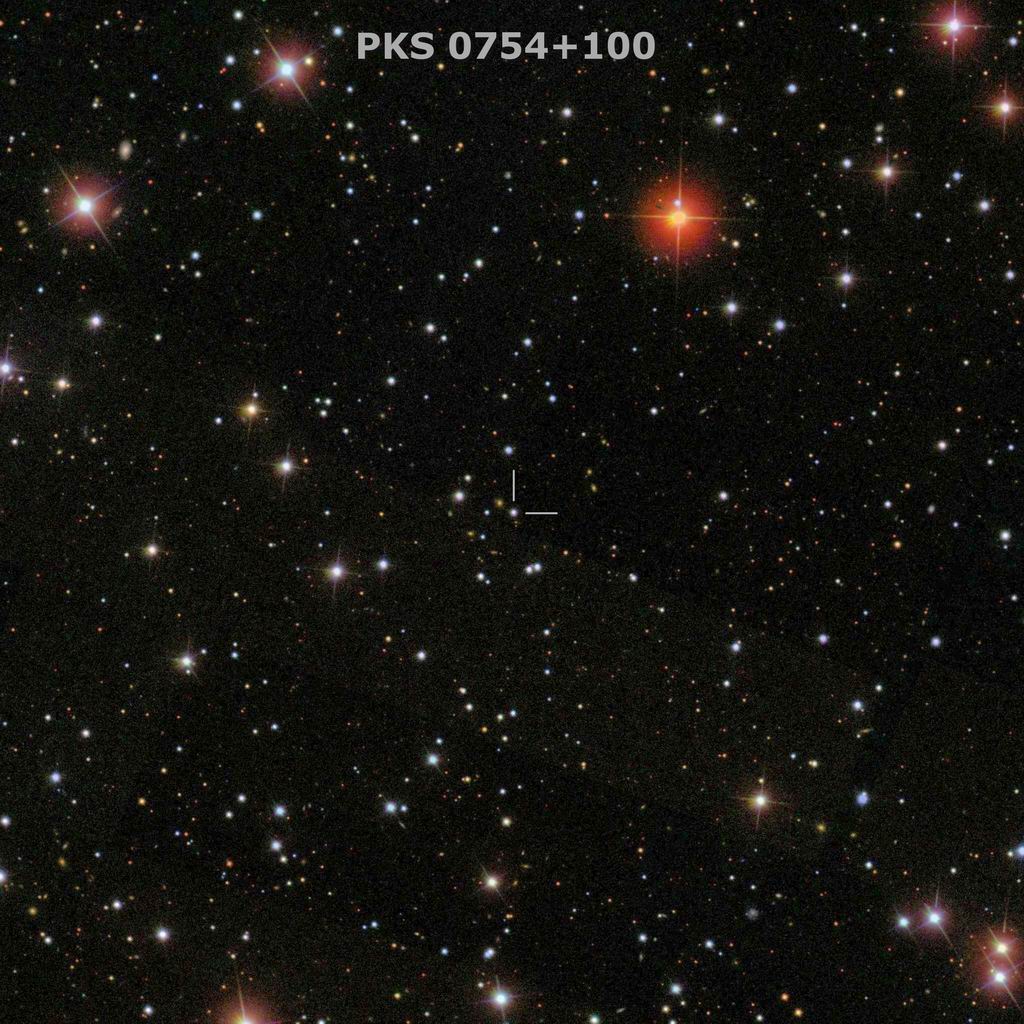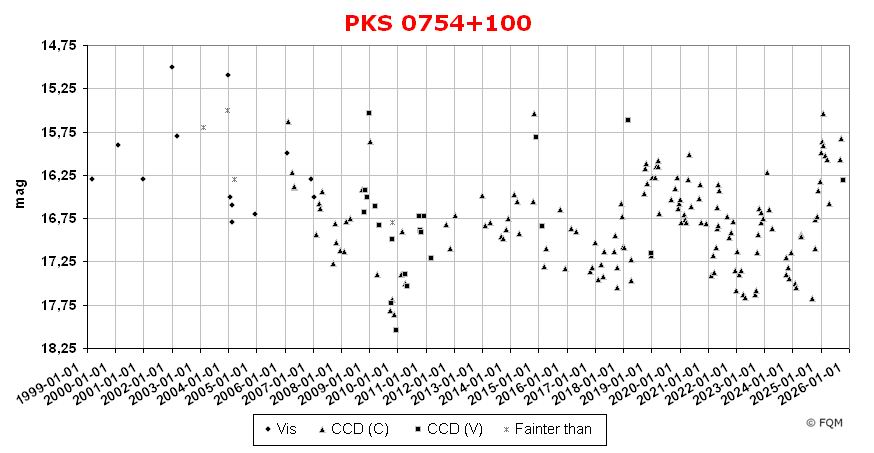
| Frankfurt Quasar Monitoring |
| PKS 0754+100 |
| Cross-Identifications |
OI+090.4, OI 090.4, IRAS F07543+1004, 0754+100 LEDA 2825311, RX J0757.1+0956, TXS 0754+100 PKS 0754+10, PKS 0754+110, PKS 0754+101 1RXS J075706.7+095647, WMAP J0757+0957 2MASS J07570663+0956348, QSO B0754+10 SDSS J075706.64+095634.8, MRC 0754+100 RGB J0757+099, WMAP J0757+0957 |
| Equat. coordinates | RA 07 57 06.7 DE +09 56 35 (J2000) |
| Constellation | Cancer |
| Type | BL Lac |
| Redshift (1) |
z=0.266 |
| Distance (2) (3) |
1033 Mpc |
| Total mag range (mv) (4) (5) |
13.46 - 18.0 |
| Catalog Magnitude (1) | 15.00 |
| Absolute Magnitude (1) | -25.7 MB |
| Light Travel-Time (2) | 2.994 × 109 yrs |

Comparison stars
| star | B | V | Rc | Ic |
| A | --- | 13.02 | 12.66 | 12.30 |
| B | --- | 13.28 | 12.88 | 12.49 |
| C | --- | 14.48 | 14.15 | 13.84 |
| D | --- | 14.80 | 14.33 | 13.90 |
| E | --- | 15.29 | 14.94 | 14.58 |
| F | --- | 15.68 | 15.25 | 14.85 |
| G | 16.36 | 15.87 | --- | --- |
| H | 16.65 | 15.91 | --- | --- |


| PKS
0754+100 is a violently variable BL Lac object in south-eastern Cancer,
close to the constellation of Canis Minor. The designation PKS 0754+100 refers
to Parkes
Radio Survey (PKS), where this object was cataloged as a radio source.
PKS 0754+100 was discovered in 1974 as a star-like radio source by the
Ohio Radio Survey and was cataloged with the designation OI+090.4
(in the literature also given as OI 090.4, OI+90.4, and OI 90.4). Follow-up spectroscopy led to the
classification as a BL Lac object due to its featureless spectrum,
rapid flux variability and strong optical polarization. Blazar PKS 0754+100 is a violently variable object with a total range of more than 4 magnitudes! Observations by the Frankfurt Quasar Monitoring project have increased the recorded total optical range by about 1 magnitude, due to several optical minima well beyond the minimum value of 16.94mv from the literature (see light curve above). On average, brightness varies between 16 mag and 17 mag. For visual observers with telescopes of 8- to 10-inch of aperture, this blazar will only be visible during maximum stage. Otherwise, larger apertures are required. The object remains stellar even with large apertures. CCD observers as well as visual observers shall use the comparison stars given above. ____________
The area of sky around blazar PKS
0754+100 is rich with bright deep sky objects, easy to observe with
small telescopes. First there is NGC
2392, the "Eskimo Nebula", a bright showpiece planetary, some
12.8° NW
in Gemini, which is rich in detail using high powers. An easy target
for binoculars is open cluster M 44, the "Beehive", some
14.3° NE in Cancer. About the same distance to the east (13.3°) we meet M 67,
another rich
and old open cluster (also in Cancer). M
48 is another nice, large and bright open cluster, 16.2° to the SSE (use low powers as with M44!). Finally,
you shall not forget to visit NGC 2346, the "Butterfly Nebula", a
box-shaped planetary, some
16° SW,
which is a nice observing target for medium and large aperture
telescopes. Those observers who like to continue with some more bright and optically variable sources of quasi-stellar photons may turn to three BL Lac objects, not too far away from blazar PKS 0754+100: - PKS 0735+17 (9° NW in Gem) - OJ 287 (17.3° NE in Cnc) - PKS 0829+046 (10° SE in Hya) |
| Adam, G. 1985, A&AS, 61, 225; UBV photometry of quasars and quasar candidates. II. Baumert, J.H. 1980, PASP, 92, 156; A Photometric History of OI 090.4 and OJ-131. Carangelo, N., Falomo, R., et al. 2003, A&A, 412, 651; Optical spectroscopy of BL Lac objects: New redshifts and mis-identified sources. Condon, J., et al. 1977, AJ, 82, 692; Optical Identifications of Parkes Sources. Craine, R.E.; A Handbook of Quasistellar and BL Lacertae Objects; Parchart Publishing House, Tuscon 1977. Cruz-Gonzales, I., Huchra, J.P. 1984, AJ, 89, 441; Continuum distributions of a x-ray observed sample of BL Lac Objects. Burbidge, G., Hewitt, A. 1987, AJ, 92, 1; An updated List of BL Lac Objects, and their Relation to Galaxies and Quasistellar Objects. Falomo, R., Ulrich, M.-H. 2000, A&A, 357, 91; Optical imaging and spectroscopy of BL Lac objects. Fiorucci, M., Tosti, G., Rizzi, N. 1998, PASP, 110, 105; VRI Photometry of Stars in the fields of 16 Blazars. Fiorucci, M., Tosti, G. 1996, A&AS, 117, 475; Automatic optical monitoring of 10 Blazars. Karge, S.; Helle Quasare für 8- bis 10-Zoll Teleskope. Ein Beobachtungsführer zur visuellen Beobachtung von Quasaren und BL Lacertae Objekten; Frankfurt 2005. Katajainen, S., Takalo, L.O., et al. 2000, A&AS, 143, 357; Tuorla quasar monitoring. I. Observations of 1995-1997. Miller, H.R., Mullikin, T.L., McGimsey, B.Q. 1983, AJ, 88, 1301; Photoelectric Comparison Sequences in the fields of four BL Lacertae Objects. Persic, M., Salucci, P. 1986, in: "Structure of Active Galactic Nuclei"; Giuricin, G., Mardirossian, F., et al. (eds.), p.675. Pica, A.J., Smith, A.G., Webb, J.R., et al. 1988, AJ, 96, 1215P; Long-term optical behavior of 144 compact extragalactic objects - 1969-1988. Puschell, J.J., Stein, W.A. 1980, ApJ, 237, 331; Observations of strongly polarized extragalactic sources. Smith, P.S., Balonek, T.J., et al. 1985, AJ, 90, 1184; UBVRI Field Comparison Stars for Selected Active Quasars and BL Lacertae Objects. Steinicke, W.; Katalog heller Quasare und BL Lacertae Objekte; Umkirch 1998. Steinicke, W.; Beobachtungsliste für helle Quasare; Umkirch 1999. Tapia, S., Craine, E., et al. 1977, ApJ, 215, L71; A new Discovery Programm for BL-Lac Objects: Results for OI 090.4 and OJ-131. Véron-Cetty, M.-P., Véron, P. 2001, A&A 374, 92; A Catalogue of Quasars and Active Nuclei: 10th edition. Véron-Cetty, M.-P., Véron, P. 2003, A&A 412, 399; A Catalogue of Quasars and Active Nuclei: 11th edition. Véron-Cetty, M.-P., Véron, P. 2006, A&A 455, 776; A Catalogue of Quasars and Active Nuclei: 12th edition. Véron-Cetty, M.-P., Véron, P. 2010, A&A 518, 10; A Catalogue of Quasars and Active Nuclei: 13th edition. Xie, G.Z., Li, K.H., et al. 1990, A&A, 229, 329; Search for short variability time-scales of BL Lacertae objects. Xie, G.Z., Li, K.H., et al. 1992, ApJS, 80, 683; CCD Photometry of 14 BL Lacertae objects and theoretical model. Xie, G.Z., Zhou, S.B., et al. 2002, MNRAS, 329, 689; Photometric monitoring of 12 BL Lacertae objects. |
| Links: Landessternwarte Heidelberg Chara/PEGA AAVSO Sloan Digital Sky Survey |
| home |